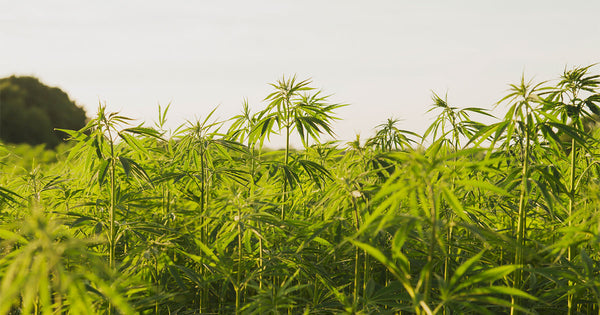What to Do with Leftover Biomass: Extracted Cannabis Biomass Uses
Feb 08, 2022

As the cannabis industry grows at a blazing fast speed, state and federal regulations and investments in waste disposal technology, infrastructure, and research have been falling behind the rapid pace of growth. Cannabis extraction has become a close second and sometimes leading product segment in some cannabis markets.
Cannabis extraction’s strong growth satisfies the growing demand for THC and CBD derivatives like concentrates, edibles, topicals, and more. However, the leftover biomass used to extract the plant's cannabinoids and terpenes has largely gone unused. Cannabis producers and processors are now seeing the many possible revenue sources from spent biomass.
What Is Cannabis Biomass?
Cannabis biomass technically refers to the plant’s stalks, leaves, and stems, not its flower buds, although many in the industry use the term to include dried flower in the definition of biomass. Cannabis processing facilities process cannabis biomass using solvents in a closed-loop extractor or solventless methods to isolate the plant’s cannabinoids and terpenes.
Cannabinoids and terpenes from the plant’s resinous trichome glands are concentrated and refined for use in various infused products, including concentrates (shatter, live resin, isolate, distillate, etc.), edibles, topicals, tinctures, and other derivative products. At the end of the process, the spent biomass is usually disposed of based on state and federal regulations.
Cannabis extraction processes that use solvents like light hydrocarbons (butane and propane) or ethanol can produce leftover biomass that may be hazardous to the environment if disposed of indiscriminately in a landfill. The Environmental Protection Agency (EPA) regulates hazardous waste disposal. Processors must first ensure if their waste is hazardous through analysis of the material.
Cannabis Biomass Waste Is Becoming a Problem
The cannabis industry is notorious for its waste generation due to strict state and federal restrictions and a lack of infrastructure and technology for cost-effective waste disposal. Cannabis waste can come from resistant child-proof packaging or spent biomass material after an extraction run.
In 2020 alone, estimates indicate that there were 135 million pounds of leftover hemp across the nation. While spent biomass has plenty of monetary value and impact on sustainability, many state regulations prevent producers or processors from using or selling the biomass, especially if it is considered hazardous waste.
A survey of over 8,000 hemp growers performed by Whitney Economics found that 48% of the farmers had leftover biomass from the year’s operations. On average, hemp farmers had about 24,795 pounds of hemp oil and processed leftovers and even leftover biomass more from the previous year due to oversupply.
One reason why hemp biomass is piling up is the recent legalization of the industry. The 2018 Farm Bill legalized industrial hemp production, causing a surge of farmers wanting to grow hemp in 2019. The rush of new hemp farmers led to an oversupply, which more than satisfied the already high demand for hemp-derived CBD products but left a lot of biomass in storage.
Up until January 2021, the U.S. Department of Agriculture (USDA) did not have final rules on industrial hemp farming and waste disposal of plants that test over the specified THC limit. At the beginning of the year, the USDA removed the need for a DEA reverse distributor or law enforcement official to dispose of the plants.
Now, hemp farmers can use traditional farm disposal practices. Disposal options include plowing the biomass under soil, mulching or composting hemp, disking, tilling, mowing, burying, or burning the leftover biomass. However, each state's agricultural department can submit its own rules for federal approval or use the USDA’s.
Despite the advancement of regulations for cannabis waste disposal, there are still many hurdles for cannabis extraction companies to jump through to dispose of leftover cannabis biomass, including the analysis of material for mold, THC, or pesticides. However, scientific research is paving the way for new uses of spent biomass.
What Can Be Done About Extracted Cannabis Biomass?

Currently, most post-extraction cannabis biomass is disposed of, wasting its inherent potential across various industries. As the cannabis waste problem grows, new disposal methods are being explored for the versatile use of leftover biomass in construction, 3D printing, cultivation, sustainable packaging, biofuels, and more industrial applications.
Instead of wasting hundreds of thousands of spent cannabis material, time, and money, farmers are increasingly choosing to sell their spent biomass to various third-party vendors or process their spent biomass on-site for different uses. The growing number of uses for old plant material can offset climate change, lower fuel emissions, and generate extra revenue streams for producers.
Scientists and engineers are developing alternative purposes and technology for the safe and cost-effective use of post-extraction cannabis material. In the lab, researchers have demonstrated the use of the material in the creation of biofuels or for carbon sequestration from the atmosphere.
Cannabis used to extract THC and hemp used for CBD extraction can be converted into various useful products. Below, we cover some of the most exciting uses for leftover cannabis material, which can include:
- Compost and mulching
- Hempcrete
- Hemp-derived plywood
- Paper
- Feed alternative
- Industrial foam
- Biofuel
Hemp Biomass as Compost
Cannabis extraction that uses solvents like hydrocarbons or ethanol are not ideal sources for compost since they may be contaminated with residual solvent after the extraction process. Instead, these may be classified as hazardous waste and require special disposal practices based on state and federal regulations.
Hemp extraction using ethanol, however, can be a potentially good source for compost since the ethanol can quickly evaporate from the material, and the moisture in the compost can offset potential risks of using ethanol in the compost. Properly processed hemp biomass can be an affordable alternative to other compost sources.
Mulching with Leftover Cannabis
Mulching with leftover cannabis material after extraction is a simple way to reduce waste. Compared to traditional mulching materials, spent biomass can work well on outdoor gardens or raised beds. Some growers opt to turn the material often to avoid trapping the solvent gas in the material.
Hemp Biomass as Livestock Feed
Leftover hemp biomass has also been considered as a livestock feed alternative. For example, hemp biomass containing ethanol could be an affordable feed supplement. Farmers can leave out the spent hemp in the sun to remove the excess ethanol content and smell that can turn off animals. However, depending on the livestock, you need to use feed approved by the USDA.
A study by researchers at Oregon State University tested the health and performance effects of feeding spent hemp biomass instead of alfalfa to lambs. Spent hemp biomass has similar protein levels and higher fat content than alfalfa. Researchers also wanted to determine if any cannabinoid residuals ended up in the meat.
During the study, sheep were fed either 10% or 20% hemp for either four or eight weeks. After the eight-week mark, sheep that were fed hemp ate more than the sheep that ate only alfalfa. When feeding dairy cows 15% hemp for four weeks, the cows produced more milk with slightly less fat.
In an American Chemical Society meeting in 2021, researchers said that “10% (leftover hemp biomass) can be included in ruminant diets without causing any detrimental effect on performance with a possible positive effect on feed intake.”
Hemp Pectin in Plywood and Lumber
In 2021, researchers at Virginia Tech University tested whether pectin, a jelly-like cannabis extraction byproduct, could strengthen plywood. Pectin is found in plant cell walls and was used
“as a modifying agent in the production of wood-based materials such as plywood and structural composite lumber.” Results are still being analyzed, but researchers have found that hemp pectin could be an affordable alternative to unsustainable materials.
Plant Lignin for 3D Printing
Lignin is a complex organic polymer found in plant cell walls to provide their rigid and woody form. Researchers from the U.S. Department of Energy’s Oak Ridge National Laboratory has created an innovative process for 3D printing feedstock that could use ligning, a common waste from spent biomass. Researchers blended the “melt-stable hardwood lignin with a low-melting nylon and carbon filter” to make the 3D printing process faster and create a stronger product.
Hemp as Sustainable Industrial Foam
Cannabis packaging and labeling regulations have increased the need for alternative and sustainable packaging options. A large majority of packaging foams are made with petrochemicals, which can have a harmful impact on the environment.
Research from SRUC and Riga Technical University (RTU) in Latvia shows that waste from wood and hemp biomass can be made into industrial foams used in packaging for insulation and cushioning. Foams created from biomass can reduce atmospheric CO2 levels.
When comparing the performance between wood and hemp-based foams, hemp showed better thermal degradation, porosity, thermal conductivity, and mechanical response. This research shows the promise of hemp-derived foams over petroleum-based foams across various industrial uses.
Extracted Hemp Biomass for Hempcrete
Hempcrete is made from lime and hemp hurd and is showing promising uses in the construction of a building’s floors, walls, and insulation. Hemp’s inner herd has a relatively high silica concentration making it bond more effectively with its lime binder. This process produces a lightweight and insulating material that weighs considerably less than concrete.
While hempcrete is not strong enough to be used as a foundation structure, it has many more possible uses. Hempcrete is a breathable material allowing moisture to escape and reduce the risk of mold. It also is able to remove carbon from the air, especially compared to alternatives like fiberglass that has a high carbon footprint.
Hemp as Biofuel

Hemp has several industrial and sustainable uses, including its conversion into biofuel to replace fossil fuels like coal. However, the necessary infrastructure to convert the hemp byproducts into a sustainable fuel source is not in place. Farmers do not have processing facilities close by that could make transporting the large volume of hemp cost-effective.
In 2010, a UConn study found that industrial hemp could be a good source of sustainable diesel fuel. Researchers found that hemp seeds could make diesel fuel. In the study, 97% of the hemp oil was turned into fuel.
A more recent study from the UK tested dual-purpose cultivars that could better convert into biofuel based on their fiber and oil characteristics. Researchers studied five varieties that made fiber only and five cultivars that produced fiber and grain. The dual-purpose cultivars had the best potential for biofuel conversion.
Jian Shi, head of the research group, said that “these combined evaluations show that industrial hemp has significant potential to become a promising regional commodity crop for producing both biofuels and value-added products. Further research is needed into the crop’s agronomic properties, post-harvesting processing, biofuel conversion, and other potential hemp coproducts.”
Cannabis Industry Focusing on Renewable Energy
Researchers and regulators are starting to focus more on the potential to create renewable energy, offset greenhouse gas emissions, and produce sustainable materials for various industries using what was once thought of as waste. Spent biomass can add many more revenue streams for an evolving market plagued by burdensome regulations.
Filter Media Sample Request
Interested in trying our filter media? We would love to send you some! Browse our products, then fill out this form and someone from our team will be in touch to finalize your request.







